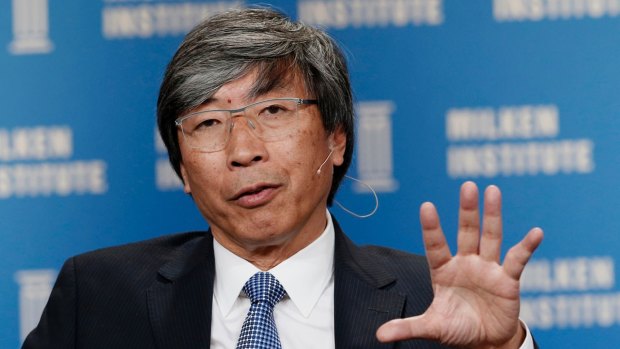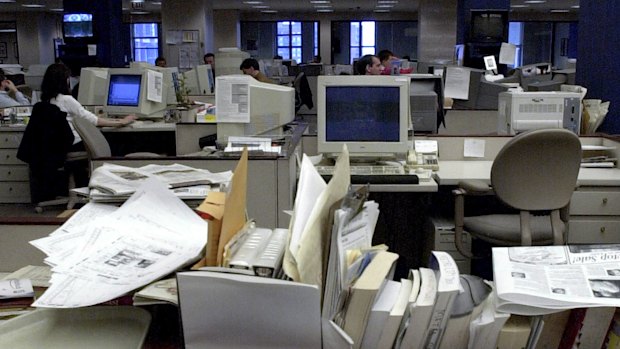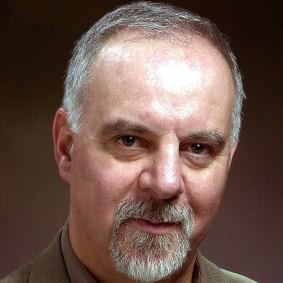This was published 7 years ago
Opinion
How a cancer doctor wants to save democracy
By Steve Lopez
Los Angeles: The body count is staggering.
In my 43 years as a journalist, armies of trained bloodhounds have been run out of newsrooms where I've worked, victims of layoffs, and buyouts, and battle fatigue. I've lost so many hundreds of colleagues, I can't keep track of where they ended up.

The good doctor: Patrick Soon-Shiong wants to take on a different kind of terminal patient. Credit: Bloomberg
These were smart, curious reporters, photographers and editors who told stories that defined place and time and made us all know each other a little better. They covered the arts and the local sports teams. They bird-dogged city councils, courts, law enforcement, school districts and other agencies that spend our tax dollars, bearing witness, asking questions and rooting out corruption.
There is less watching today, even though California's population has nearly doubled since I began my career, and we are all poorer for it.
It might seem like the opposite is true - that there's more information available than ever, because of incessant chirping on cable news, nightly car chases on local outlets, digital news sites and social media news feeds.
But what's vanished or been greatly diminished in far too many places is good, solid reporting on local and state affairs, and we don't even know what that has cost us through mismanagement, misuse of funds and outright corruption.
Sure, the Los Angeles Times and other papers can still pull off exposes such as the freeloading scandal in Bell or the payola bonanza involving the developer of a Harbour City project. Just note the Pulitzer won by The East Bay Times last year for its coverage of the Ghost Ship fire - an achievement its staff earned after years of deep cuts and consolidation.

Many newsrooms have so many empty desks, they look like furniture showrooms.Credit: AP
But those investigations take lots of time and people, and they don't happen as often as they should because fewer and fewer snoops are checking records, knocking on doors and making a nuisance of themselves.
To better describe what's happened to the business, let me take you back to 1975. I'd just got my first job out of college, as a sportswriter in the Sacramento suburbs. I was assigned to the Davis branch of The Woodland Daily Democrat at a weekly salary of $135.
Today, there is no Davis branch. When I checked with the Daily Democrat last week, editor/reporter/photographer Jim Smith told me that, in the past 20 years, his staff of 15 has gone down to just five.

Steve Lopez is a columnist for the Los Angeles Times. Credit: Los Angeles Times/MCT
I moved from the Daily Democrat to three nearby newspapers over the next few years - The Pittsburg Post-Dispatch, Concord Transcript and Oakland Tribune, where I pulled a switch from sports to news. None of those papers still exist.
My next stop was The San Jose Mercury News, a storied newspaper with a first-rate editorial staff of about 400 at its height. Today the Mercury News is down to about 110 people and has lost about 70 per cent of its staff in the last two decades, even as Silicon Valley became one of the most important stories in the world.
I saw the same trends in my years with The Philadelphia Inquirer and Time magazine, and the problem was never a lack of public demand for news.
What changed was that the internet offered new options to advertisers, and newspaper revenues diminished despite ongoing attempts to make the industry more digitised. Soon, newsrooms had so many empty desks, they looked like furniture showrooms.
Bankruptcies and shutdowns followed, independent voices became corporatised, and the cost of continued profits was more bloodshed.
Consider this: the first five newspapers I worked for - in Woodland, Pittsburg, Concord, Oakland and San Jose - were folded into a single company over time. That company is Digital First Media, which has followed the same consolidation pattern with its newspapers in Southern California.
A smarter guy would have got out of the business. But I didn't know how to do anything else, so I kept moving, like a man trying to outrun a wildfire. Behind me, the earth was scorched. But there was no smoke rising in Los Angeles when I arrived 17 years ago, so I told myself this was it. Between the mountains and the beach, a million untold tales. No more running for me, except to chase good stories and bad actors.
I wish I could tell you it's been nothing but cupcakes and cartwheels ever since, but the Los Angeles Times got hit by the same beetle that sawed through the rest of the industry, and the staff today is just more than one-third the size it was when I started.
I can't tell you how many clowns, buffoons and scoundrels have taken the reins of the parent company, promised great things and then fled in the night with blood on their hands and briefcases full of money.
You get to thinking there's no way out. Then you wake up one day and hear that somebody wants to come to the rescue.
Naturally, you're sceptical. It's a professional duty.
I've never met billionaire Dr Patrick Soon-Shiong, who is closing a deal to take over the Times, The San Diego Union-Tribune, Hoy and our community newspapers. You'd think a man whose goal is to cure cancer would have his hands full, but now the good doctor wants to take on a different kind of terminal patient.
Soon-Shiong dropped by the office on Friday and told his story. He grew up in South Africa during apartheid, locked out of all-white schools as an Asian. In his first job as a doctor, he got half the pay of white doctors. He moved on to Canada and later Los Angeles, making a home - as an Asian African American - in one of the most diverse places in the world.
He said he wanted to grow the paper, that he believes in compassion and consideration, and that the business model is quality, and that the newspaper's role in the community is vital. He wants the Times to be a beacon, a barrier against the tides of fake news, a voice of the West and beyond.
Was this a hoax?
Right after Soon-Shiong said the newspaper is a public service in the private sector, I wondered if he'd pull off a mask to reveal the face of a Tribune or Tronc executive.
But it didn't happen, and it was nice, after years of casualties, to hear someone talk about rebuilding locally, nationally and internationally.
Dying of thirst, we wanted to drink the Kool-Aid, even after Soon-Shiong shocked the room with news that the home office is moving to El Segundo, with a satellite office downtown.
Talk is cheap, though, as we were repeatedly reminded by previous owners.
We'll work hard. We'll hope for the best.
We'll see.
I can't kid you. We've lost tons of knowledge and experience over the years. But what's left is a lot of talent, hunger, young energy and diversity, and a fighting spirit that led to formation of a union to take on the evil deeds of corporate thugs and beat a drum on pay disparities.
Here's hoping Soon-Shiong comes through on the promise to grow the paper's staff and reach, because the city and state need more watchdogs, more eyes and ears in places where today there is no witness to the daily dramas that shape our lives.
I feel like I was in hospice and a new doctor said: "Hold on, don't plan the funeral just yet."
With appreciation, I thought back on how I almost ended up in an entirely different line of work.
My 60 job queries in 1975 got me nowhere - post-Watergate, a glut of wannabe journalists couldn't get through the door. I was so discouraged that I grabbed the classified ad section of the Sunday San Francisco Chronicle-Examiner to look for any kind of job, and I saw a listing for a car salesman.
Why not?
I called and made an appointment for an interview. After I hung up, I saw an ad in the same section.
Sportswriter wanted.
Gary Traynham, sports editor of The Woodland Daily Democrat, told me I was too late, the job was all but filled. I begged him to reconsider. He agreed to read my stuff from The San Jose State Spartan Daily, and after he did, I got the job.
As far as I could recall, I never thanked Traynham for giving me my big break.
Last week, I called to fix that.
Traynham, who retired 10 years ago after witnessing the long, slow decline of the industry, told me it was nice for an old man to be remembered for something.
And he wished us luck with the new guy.
Steve Lopez has been a Los Angeles Times columnist since 2001. He has won more than a dozen journalism awards, is a two-time Pulitzer finalist and winner of the PEN USA Literary Award for Non-Fiction.
Los Angeles Times